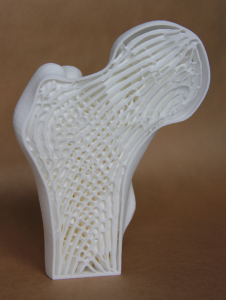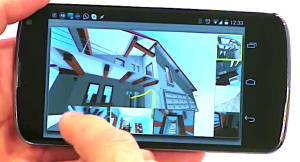T1: Introduction to crowd simulation
Julien Pettré – Inria, Nuria Pelechano – Universitat Politecnica de Catalunya (UPC) – Barcelona
Session details: Monday 24 April, 9:00 - 10:30 and 11:00 - 12:00 Room: Rhône 1

Crowd simulation is today a frequently used computer animation technique in the field of video-games or the one of visual effects for movies. It is used to populate game scenes and make them lively and interactive, or to generate background characters in movies. The topic received a lot of attention in the research community. Many simulation algorithms were proposed to simulate crowds. How do they work? How are they concretely used in the field? This tutorial is clearly intended for beginners and all who are curious about the topic, and will present the basics of crowd simulation. It will also address some related questions such as the one of animation and rendering of crowd characters.
T2: Topology Optimization for Computational Fabrication
Jun Wu – TU Delft, Niels Aage – TU Denmark, Sylvain Lefebvre – Inria, Charlie Wang – TU Delft
Session details: Monday 24 April, 9:00 - 10:30 and 11:00 - 12:00 Room: Rhône 2

Additive manufacturing (AM) and topology optimization (TO) form a pair of complementary techniques in transforming digital models into physical replicas: AM enables a cost-effective fabrication of geometrically complex shapes, while TO provides a powerful design methodology for generating optimized models, which are typically complex from a geometric perspective. The potential of both techniques has recently been explored in graphics, resulting in fantastic applications especially regarding structural and aesthetic properties of fabricated models. In this tutorial, we start from the fundamentals of AM and TO, and proceed to advanced TO techniques which steer the optimization process, i.e., taking into account the manufacturing as well as aesthetic appearance.
T3: Computer Generated Display Holography
Petr Lobaz – University of West Bohemia
Session details: Monday 24 April, 9:00 - 10:30 and 11:00 - 12:00 Room: Rhône 3

« A hologram » is a ubiquitous term when talking about realistic 3-D illusion. « Holographic display » seems to be the holy grail of 3-D display technology, at least according to news headlines. But what « holographic » actually means? The tutorial explains basics of holography, the lensless imaging method, invented by Gabor and Denisyuk in the mid-twentieth century, that produces breathtaking 3-D images – holograms. Then it explains basic steps of transition from classical to digital holography and to computer generated display holography – a counterpart of computer graphics that does not calculate an image, but a hologram. The tutorial also covers holographic printing, holographic electronic displays and compares them to competing technologies.
T4: Mobile Graphics
Marco Agus – CRS4 and KAUST, Enrico Gobbetti – CRS4, Giovanni Pintore – CRS4, Pere-Pau Vázquez – Universitat Politècnica de Catalunya and Fabio Marton – CRS4
Session details: Monday 24 April, 13:30 - 15:00 and 15:30 - 16:30 Room: Rhône 1

The increased availability and performance of mobile graphics terminals, including smartphones and tablets with high resolution screens and powerful GPUs, combined with the increased availability of high-speed mobile data connections, is opening the door to a variety of networked graphics applications. In this world, native apps or mobile sites coexist to reach the goal of providing us access to a wealth of multimedia information while we are on the move.
This half-day tutorial provides a technical introduction to the mobile graphics world spanning the hardware-software spectrum, and explores the state of the art and key advances in specific application domains, including capture and acquisition, real-time high-quality 3D rendering and interactive exploration.
T5: Partitioning Surfaces into Quad Patches
Marcel Campen – New York University
Session details: Monday 24 April, 13:30 - 15:00 and 15:30 - 16:30 Room: Rhône 2

The efficient and practical representation and processing of geometrically or topologically complex shapes often demands some form of virtual partitioning into pieces, each of which is of a simpler nature. Due to their regularity, highly structured networks of conforming quadrilateral patches, called quad layouts, or in particular instances quad meshes, are most beneficial in many scenarios; they enable the use of tensor-product representations based on NURBS or Bézier patches, grid-based multiresolution techniques, or discrete pixel-based map representations. However, partitions of this type are particularly complicated to create due to the inherent structural restrictions. Research in geometry processing has led to a variety of automatic or semi-automatic approaches to address this problem. This course provides a detailed introduction to this range of methods, treats their strengths and weaknesses, discusses their applicability and practical limitations, and outlines open problems in this field.
T6: Position-Based Simulation Methods in Computer Graphics
Jan Bender – RWTH Aachen University, Matthias Müller – NVIDIA PhysX Research, Miles Macklin – NVIDIA PhysX Research
Session details: Monday 24 April, 13:30 - 15:00 and 15:30 - 16:30 Room: Rhône 3

The physically-based simulation of mechanical effects has been an important research topic in computer graphics for three decades. In recent years position-based simulation methods have become popular. In contrast to classical approaches these methods compute the position changes in each simulation step directly, based on the solution of a quasi-static problem. Therefore, position-based approaches are fast, stable and controllable which make them well-suited for use in interactive environments. However, these methods are generally not as accurate as force-based methods but provide visual plausibility. Hence, the main application areas of position-based simulation are virtual reality, computer games and special effects in movies and commercials.
Tutorials Chairs
For any question contact the tutorial program co-chairs: chairs-eg2017tutorials@eg.org
Adrien Bousseau (adrien.bousseau@inria.fr), Inria, France
Diego Gutierrez (diegog@unizar.es), Universidad de Zaragoza, Spain
